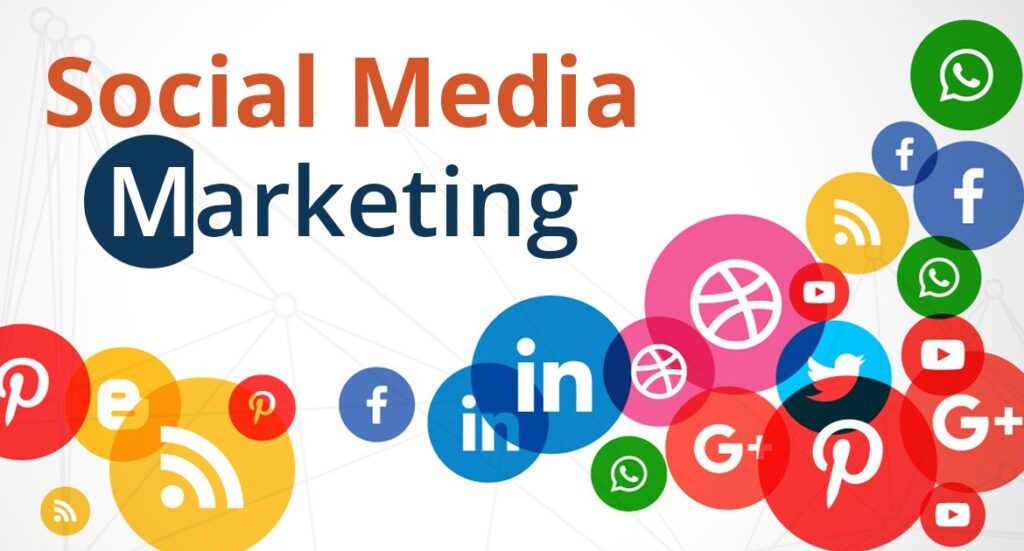
Social media marketing is also known as digital marketing & e-marketing. SMM is the platform, on which users build social networks. And also shares data to build a company’s brand, increase sales, &drive website traffic. In addition to providing companies with a way to engage with existing customers and reach new ones. SMM has purpose-built data analytics that allows marketers to track the success of their efforts, make digital marketing strategies,& identify more ways to engage.
Social media marketing uses social media and social networks—like Facebook, X platform (formerly Twitter), and Instagram—to market products and services, engage with existing customers,& reach new ones. The power of social media marketing comes from the unparalleled capacity of social media in three core marketing areas: connection, interaction, and customer data. SMM has transformed the way businesses are able to influence consumer behavior, from promoting content that drives engagement to extracting personal data that makes messaging with users. Because social media today is so ubiquitous, marketing techniques using these platforms are extremely important for businesses & using digital marketing strategies. SMM is often more cost-effective with great exposure, though it requires ongoing maintenance and might have unintended negative feedback consequences.
Why Is Social Media Marketing(SMM) So Powerful?
The power of SMM is driven by the unparalleled capacity of social media with digital marketing strategies in three core marketing areas: connection, interaction, and customer data.
Connection: Not only does social media enable businesses to connect with customers in ways that were previously impossible, but there is also an extraordinary range of avenues to connect with target audiences—from content platforms (like YouTube) and social sites (like Facebook) to microblogging services (like X platform).
Interaction: The dynamic nature of the interaction on social media—whether direct communication or passive liking—enables businesses to leverage free advertising opportunities from eWOM (electronic word-of-mouth) recommendations between existing and potential customers. Not only is the positive contagion effect from eWOM a valuable driver of consumer decisions, but the fact that these interactions happen on the social network makes them measurable. For eg, businesses can measure their social equity- a term for the return on investment(ROI) from their SMM campaigns.
Customer Data: A well-designed social media marketing plan delivers another invaluable resource to boost marketing outcomes: customer data. Rather than being overwhelmed by the 3Vs of big data(volume, variety, and velocity), SMM tools have the capacity not only to extract customer data but also to turn this gold into actionable market analysis—or even to use the data to crowdsource new strategies.
How Social Media Marketing (SMM) Works
As platforms like Facebook, X, & Instagram took off, social media transformed not only the way we connect with one another but also the way businesses are able to influence consumer behavior, from promoting content that drives engagement to the extracting of geographic, demographic, and personal information that makes messaging resonate with users.
Advantages and Disadvantages of SMM
Advantages
The introduction of social media marketing has introduced a new suite of benefits. Social media platforms provide a powerful channel for reaching and engaging with a large audience, which can help increase brand awareness and recognition.
Engaging with customers through social media channels can help build stronger relationships and foster customer loyalty. It’s often a less expensive option than traditional advertising methods, making it more appealing for smaller or start-up businesses.
The nature of social media marketing also has plenty of benefits. Sharing links to your website or blog on social media can help drive more traffic to your website and increase conversions. In addition, social media provides a way to gather feedback from customers in real-time, allowing for instant interaction and simplicity in communication.
Social media marketing also has the benefit of being broad but also targeted. Social media can help businesses reach a wider audience & increase engagement through shares, likes, comments, and other forms of interaction. This is especially true considering when customers forward content along to non-customers. On the other hand, social media platforms can pinpoint or target specific demographics, interests, &behaviors, & deliver personalized content to those audiences.
Disadvantages
Though riddled with benefits, there are some downsides and complications to social media marketing. Building a strong social media presence takes time and effort, and business owners must often consistently engage and create content.
Effective SMM requires a deep understanding of the various platforms, as well as the ability to create engaging content, analyze data, & make data-driven decisions. Each platform is often specialized and requires its own understanding. In addition, social media platforms are constantly changing their algorithms and policies which can make it difficult to predict and maintain success.
Though social media makes it easy to communicate with customers, it also provides a platform for customers to voice their complaints and grievances publicly. This may have the unintended consequence of creating a public forum which can damage a company’s reputation if not handled properly.
Last, it may be difficult to clearly understand the return on social media marketing. Measuring the effectiveness and ROI of social media marketing can be challenging as it often involves tracking multiple metrics, analyzing complex data sets, & making assumptions about why consumers may have acted in various ways.
Pros
- May help companies enhance brand recognition easily
- Offers companies more cost-effective solutions with great exposure
- It may be leveraged to increase website traffic and real-time feedback
- May be leveraged for targeted or specific engagements
Cons
- It may be time-consuming to set up and maintain
- It may be unpredictable, as different platforms may change algorithms
- This may result in negative feedback displayed in a very public fashion
- May be difficult to fully understand the true ROI
What Is Sticky Content in Social Media Marketing?
Sticky content is the marketing term for attractive content that engages customers at first glance. And also influences them not only to purchase products but also to share the content.
What Is Viral Marketing in Social Media Marketing?
It helps to spread word-of-mouth product information—a very simple & inexpensive way to promote sales.
What Is Earned Media in Social Media Marketing?
Earned media is a marketing term for brand exposure other than paid advertising. For E.g. customer-created content ranging from product reviews & recommendations to shares, reposts, & mentions.
How Can One Get Started in Social Media Marketing?
To start working in SMM, it is good to have at least a bachelor’s degree in marketing & digital marketing strategies. Then, it’s critical to gain a good understanding of how marketing campaigns work on platforms like Facebook, X, and Instagram. After that, showcase your talents by creating compelling content. Follow influencers and other social media marketers to learn what they are doing well and where they fall flat. Together, use these steps to create a personal brand that you can use to sell yourself and your work.
